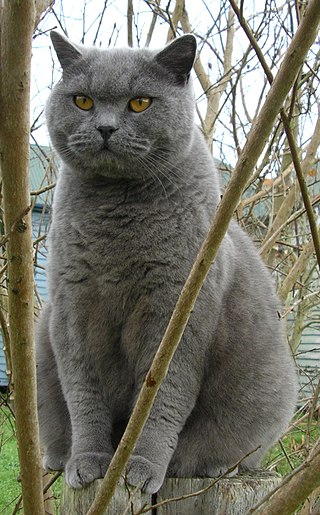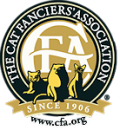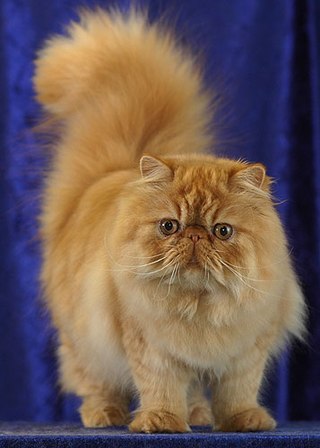
The British Shorthair is the pedigreed version of the traditional British domestic cat, with a distinctively stocky body, thick coat, and broad face. The most familiar colour variant is the "British Blue", with a solid grey-blue coat, pineapple eyes, and a medium-sized tail. The breed has also been developed in a wide range of other colours and patterns, including tabby and colourpoint.

The Bengal cat is a domesticated cat breed created from a hybrid of the Asian leopard cat, with domestic cats, especially the spotted Egyptian Mau. It is then usually bred with a breed that demonstrates a friendlier personality, because after breeding a domesticated cat with a wildcat, its friendly personality may not manifest in the kitten. The breed's name derives from the leopard cat's taxonomic name.

The Sphynx cat also known as the Canadian Sphynx, is a breed of cat known for its lack of fur. Hairlessness in cats is a naturally occurring genetic mutation, and the Sphynx was developed through selective breeding of these animals, starting in the 1960s.

The Maine Coon is a large domesticated cat breed. It is one of the oldest natural breeds in North America. The breed originated in the U.S. state of Maine, where it is the official state cat.

The Scottish Fold is a breed of domestic cat with a natural dominant gene mutation that affects cartilage throughout the body, causing the ears to "fold", bending forward and down towards the front of the head, which gives the cat what is often described as an "owl-like" appearance.

The Birman, also called the "Sacred Cat of Burma", is a domestic cat breed. The Birman is a long-haired, colour-pointed cat distinguished by a silky coat, deep blue eyes, and contrasting white "gloves" on each paw.

The Cat Fanciers' Association (CFA) was established in the United States in 1906. The CFA is currently the world's largest registry of pedigreed cats. Originally headquartered in Manasquan, New Jersey the CFA moved to Alliance, Ohio in 2010. The association's stated mission is preserving and promoting pedigreed breeds of cats while also enhancing the well-being of all cats. CFA's first licensed cat shows were held in Buffalo, New York and Detroit, Michigan in 1906. The association today has a known presence in Europe, China, and Japan along with its well-established activity in the United States and Canada.
Hypertrophic cardiomyopathy is a condition in which muscle tissues of the heart become thickened without an obvious cause. The parts of the heart most commonly affected are the interventricular septum and the ventricles. This results in the heart being less able to pump blood effectively and also may cause electrical conduction problems.

The Ragdoll is a breed of cat with a distinct colorpoint coat and blue eyes. Its morphology is large and weighty, and it has a semi-long and silky soft coat. American breeder Ann Baker developed Ragdolls in the 1960s. They are best known for their docile, placid temperament and affectionate nature. The name 'Ragdoll' is derived from the tendency of individuals from the original breeding stock to go limp and relaxed when picked up. The breed is particularly popular in both the United Kingdom and the United States.

The Siberian is a centuries-old landrace of domestic cat in Russia, and recently developed as a formal breed with standards promulgated the world over since the late-1980s. Since 2006, the breed is recognised for registry and championship status with all major cat registries.

The Singapura is the smallest breed of cat, noted for its large eyes and ears, ticked coat, and blunt tail. Reportedly established from three "drain cats" imported from Singapore in the 1970s, it was later revealed that the cats were originally sent to Singapore from the United States before being exported back to the US. Investigations by the Cat Fanciers' Association (CFA) concluded that no wrongdoing had occurred and the Singapura kept its status as a natural breed.

The Turkish Angora is a breed of domestic cat. Turkish Angoras are one of the ancient, natural breeds of cat, having originated in central Anatolia. The breed has been documented as early as the 17th century. Outside of the United States, the breed is usually referred to as simply the Angora or Ankara cat. These cats have slender and elegant bodies. In the winter they are perfectly camouflaged in the snow.
Purebreds are "cultivated varieties" of an animal species achieved through the process of selective breeding. When the lineage of a purebred animal is recorded, that animal is said to be "pedigreed". Purebreds breed true-to-type which means the progeny of like-to-like purebred parents will carry the same phenotype, or observable characteristics of the parents. A group of purebreds is called a pure-breeding line or strain.

The Governing Council of the Cat Fancy (GCCF) is a cat registry, established in 1910 and the largest organisation that registers pedigree cats in the United Kingdom. It was formed from a small number of cat clubs which were registering cats at the time when the modern cat fancy was in its first stages. It is considered to be the original prototype for cat fancy registries. It is an independent body with around 150 member clubs, including specialist breed clubs and area clubs covering particular regions. The GCCF became an incorporated company on 5 November 2010. It licenses cat shows put on by its affiliated clubs with about 135 shows per year. Pedigree cats shown at these shows can gain the titles Champion, Grand Champion, Imperial Grand Champion and Olympian. The latter having three levels, Bronze, Silver and Gold. The word Champion is replaced by Premier for neutered cats, and Master Cat for cats competing in household pets. The showing of non-pedigree cats and Pedigree Pets is also popular at GCCF shows.

The Savannah is a breed of hybrid cat developed in the late 20th century from crossing a serval with a domestic cat. This hybridization typically produces large and lean offspring, with the Serval's characteristic large ears and markedly brown-spotted coats. F1 and F2 male Savannahs can be very large, and in 2016 an F2 male attained a world record for tallest cat at 48.4 centimetres (19.1 in). Show-eligible F4–F5 cats range from 5.0 to 8.2 kilograms however, comparable in size to other large domestic cat breeds such as the Maine Coon or Norwegian Forest cat.

The Brazilian Shorthair is a breed of cat. It is the first cat breed from Brazil to receive international recognition.

The Abyssinian is a breed of domestic short-haired cat with a distinctive "ticked" tabby coat, in which individual hairs are banded with different colors. They are also known simply as Abys.

The Persian cat, also known as the Persian longhair, is a long-haired breed of cat characterised by a round face and short muzzle. The first documented ancestors of Persian cats might have been imported into Italy from Khorasan as early as around 1620, however, this has not been proven. Instead, there is stronger evidence for a longhaired cat breed being exported from Afghanistan and Iran from the 19th century onwards. Widely recognised by the North-West European cat fancy since the 19th century, and after World War II by breeders from North America, Australia and New Zealand. Some cat fancier organisations' breed standards subsume the Himalayan and Exotic Shorthair as variants of this breed, while others generally treat them as separate breeds.

The Balinese is a long-haired breed of domestic cat with Siamese-style point coloration and sapphire-blue eyes. The Balinese is also known as the purebred long-haired Siamese, since it originated as a natural mutation of that breed and hence is essentially the same cat but with a medium-length silky coat and a distinctively plumed tail.

Puppy cat is a term used to refer to specific breeds of domestic cats that have unusual behavioral tendencies that are reminiscent of young domestic dogs. These are within the scope of feline behavior, and may be enhanced through selective breeding. These behaviors, not specific to any breed, include following people around from room to room, the desire to receive frequent moments of physical affection such as being held and petted, a lack of aggression toward some fellow animals, and a placid nature. While these attributes are found desirable for owners interacting with their cats, problems can occur when the felines are exposed to dogs and people who wish to harm them, with the cats possibly being too trusting and too friendly for their own good. Breeds known for these canine behaviors include the Abyssinian, Burmese, Maine Coon, Manx, and Ragdoll, though dog behavior traits can appear regardless of breed.


















